Trains, Trains, Boat, and More Trains: The Journey to Ireland Begins
We picked up our belongings and headed to the train station. Our first train was running a little late, which was concerning since we were already facing a complex journey across the county and through Wales to get to the ferry terminal at Holyhead. The train set off at a crawl—not a great sign—and due to signal issues, it was delayed on our first change. Then, the next two possibilities for onward trains were canceled. After a quick chat at the information kiosk, we were advised to take a slightly different route, with the train leaving in a couple of minutes. So, we dashed to catch this train. Upon arriving in Leeds, the question was posed as to what to do with our time in Leeds. My immediate response was to try and catch an earlier train! Soon, we were seated on a comfortable TransPennine train, charging our phones. The rest of the journey seemed to have a bit of a following wind, and we arrived in Holyhead only an hour later than expected, mainly thanks to one of the connecting trains being delayed enough for us to catch it. Next, we wandered around and then decided to settle into McDonald’s for the evening. We had decided to try out the overnight ferry, adopting the common backpacker approach of saving on accommodation by traveling overnight. So, we settled into an evening of reading and doing Duolingo while waiting for our ferry.
The process for checking bags in Holyhead was a little more involved than we expected and with our valuable distributed through out our bags we had a slight panic when they mentioned that big bags needed to be checked in, until we checked that our bags were small enough to go on as hand luggage. There was another moment of worry when I thought my spork might be considered a sharp object, as no gas, knives, or sharp objects were allowed. However, the bag scanning process was relaxed on the way out, and we were soon waiting for the coach to take us onto the ferry.
The Hygge Lounge with reclining seats was quiet space although the chairs looked good they were a little tricky to sleep on. That said it was nice to be able to relax, recharge our battery pack and I was glad of my eye mask to help block out the light to allow me to get about 3 hours of broken sleep, and then enjoyed a free hot drink in the morning.
Kildare’s Calm: In the Footsteps of Saint Brigid and Beyond
We made the classic backpacker’s error of pre-booking our bus to the train station with the ferry company. First, we found out that people buying their tickets directly on the bus were paying less, and then we discovered that we had to wait for the Irish ferry passengers, who were sailing half an hour after us. As we waited, some of the more impatient passengers succumbed to the temptation of taking one of the taxis parked behind us, being picked off one by one when their willpower broke. We held our nerve, knowing there were quite a few trains that could take us where we wanted to go next.
With a bit of a dash across the train station, we managed to get our paper tickets and catch the 7:20 train to Kildare.
We arrived in Kildare while most people in the town still seemed to be asleep. We followed a heritage trail past the visitor centre, a historic cathedral, learning about St. Brigid as we went. Some of her stories, including how she punished two monks for not accepting a meal from a kind host while they were fasting, felt like a reminder to follow the spirit of the rules, not the letter of the law.
Next, we made our way past another church, the spiritual centre, and the Black Castle to visit St. Brigid’s Spring, with its lovely, quiet, reflective space.
Then, we wandered over to the café at the Japanese gardens and spent a reflective hour having a drink and soaking up the amazing atmosphere, surrounded by blossoms and water. With the trains not being super frequent, we headed back to the station the long way, visiting a few more sights, including a heritage center and a castle tower.
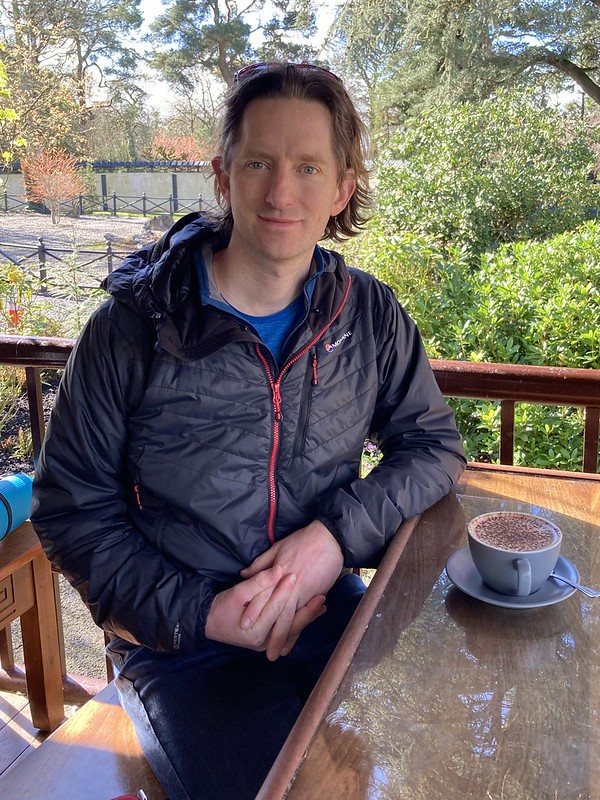
On arriving in Carlow, the lack of sleep the night before was catching up with us. We visited the tourist information to see if we could find out anything useful, then went to our accommodation, which was a little harder to find than expected.
Following the Flow: Adventure Along the Barrow Way
After a night on the ferry with very little sleep, we were both grateful for a good night’s sleep. In the morning, with trains not being too frequent and a lengthy run/walk/exploration planned, we got up early to catch the 8:22 train heading south for one stop.
Upon arriving at Muine Bheag / Bagenalstown, we explored the town on our way to Royal Oak before starting our run back along the Barrow Way, which follows the river and the canal. Our plan was to return to Carlow with a mix of running, walking and sightseeing. We were not disappointed with interesting stops along the way including
Sights included a swimming area by the weir; canal locks of Reas Lough and Allens Lough, a wildlife sanctuary on an island between the river and canal. The moving 1916 monument that honours Fr Albert Bibby and Nurse Margaret Kehoe for their involvement in 1916.
Then, we arrived at our next major settlement, Leighlinbridge. We discovered more castles damaged by Cromwell—Leighlinbridge’s Black Castle was hit by cannon fire!
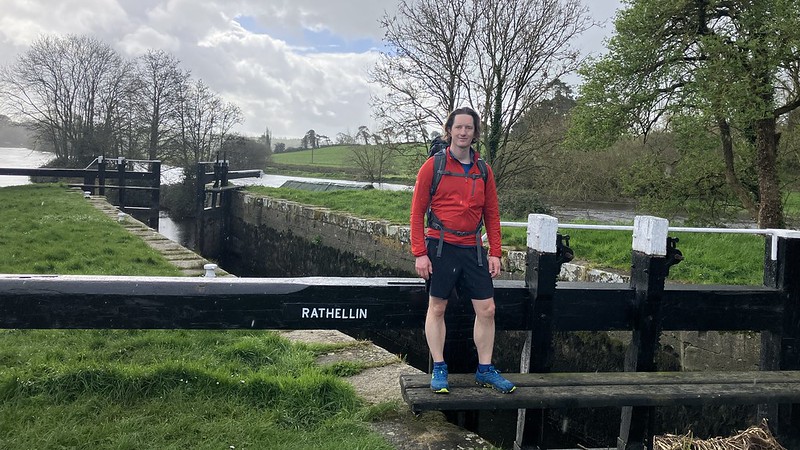
Leighlinbridge was a really lovely settlement. We headed through and decided to investigate what the Arboretum Home and Garden Haven was, finding ourselves in for a treat. At this large garden centre, we enjoyed some lovely soup and a much-needed break before touring their garden. Then, after a short section on a busy road, we were back on the river towpath heading north. After allowing our food to settle, it was time for a little more running. After passing a few more locks on the lateral canals, we made it to Milford Mill and took another break, this time with hot chocolate at the lovely woodland cafe there. Then, we wandered over to the old mill and picked up the trail heading north again. Before long, we started to see more buildings, and the top of the castle signalled our arrival back in Carlow.
That evening, we popped up to Tesco to pick up supplies and dinner.
Castles and Cathedrals: A Historic Stroll through Kilkenny
I’m not sure I’ve ever visited so many castles and churches in one day.
We took the 8:22 train to Kilkenny and started our day with a walk to Kilkenny Castle, passing Maudlin Castle from the 16th century. Then, crossing over the bridge, we embarked on a self-guided tour of Kilkenny Castle, utilising the following audio guide:
https://m.soundcloud.com/opwireland/1-welcome-to-kilkenny-castle?in=opwireland%2Fsets%2Fkilkenny-castle-2022 The castle has been restored to its 19th-century decor.
Afterward, we took a stroll through the stables and the gardens at the back, then headed over to see the 13th-century Talbots Tower, which was part of the fortified town. Following the line of the wall, we visited other sections of the city walls, including the newer St. Mary’s Cathedral and moving on to the Black Abbey from the 13th century before reaching the cathedral the city is named after, St. Canice’s Cathedral (13th century). After climbing the tower to enjoy the views of the city, we explored the cathedral with the audio tour.
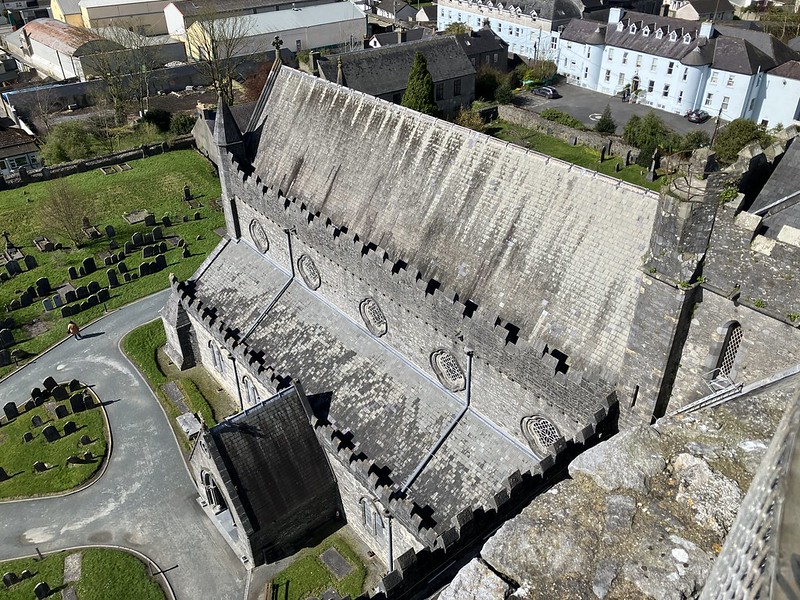
Then, we headed down to the river, strolled back along the medieval mile a bit around the castle’s parkland and river, and headed back to the train station. With nearly 12 km under our belts, we can definitely say there is plenty in the city to keep tourists busy, and we had a great visit.
With a busy train journey back to Carlow and diner at Neko Asian Street food and then a relaxing evening with an early night.
Echoes of Shackleton: Reflecting on Resilience in Athy
The train this morning was slightly later and busier as we headed to Athy, eager to experience more of the Barrow Way. We planned to run and walk back along the river after visiting the Shackleton Memorial.
I have had a long-standing fascination with Shackleton, especially his legendary survival and rescue mission. His leadership, resilience, and unwavering commitment to his crew, particularly during the harrowing journey to South Georgia and the subsequent rescue attempts, are truly inspiring.
Shackleton’s story is a powerful reminder of the strength of the human spirit, leadership by example, and the importance of supporting those around us, even in the face of great challenges.
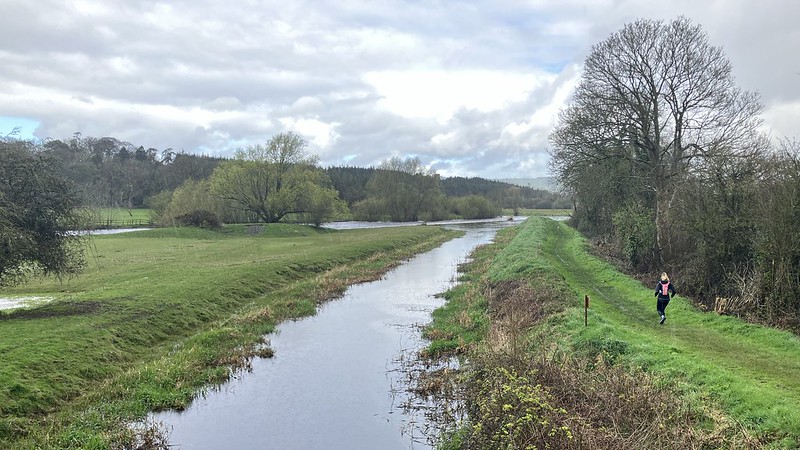
So we began with a lap around the town, visiting the medieval church and graveyard, the currently closed Ernest Shackleton Museum, White Castle, and then crossed the bridge. Heading north along the river, we glimpsed Woodstock Castle before embarking on our journey south along the Grand Canal. Eventually, we rejoined the River Barrow at the picturesque Horse Bridge. From here, we alternated between running and walking. The initial scenery was stunning, though the elusive kingfishers remained just that—elusive. Our route mixed running along the lateral canals with sections beside the river. Although this day’s route had less variation, we made up for it with a quicker pace, covering a greater distance by running. Notable sights along the way included Levitstown Mill, sadly burnt out by a fire, and Dunrally Bridge, which crosses the river and connects two counties.
Gardens and Greenery: A Tranquil Day in Carlow
Today, our plans for a relaxing day in Carlow turned into more hiking than we anticipated. It all began with a trip to the Delta Sensory Gardens, which didn’t open until 11 am, affording us a leisurely start to the morning for once.
Our stroll along the river and through the industrial estate made us question whether there really was a group of gardens just around the corner! After a delightful chat with Bob, the sculptor, while taking shelter from the rain, we were rewarded by having the gardens almost to ourselves that morning. Upon downloading their app, we embarked on the audio tour as we meandered through the gardens. https://apps.apple.com/gb/app/delta-sensory-gardens/id1632189720
Each garden showcased a unique theme, all of which were breathtaking. Among my favourites were the waterfalls, featuring a blend of water sculptures, plants, and sounds—the sheer sensation of the water sheet was mesmerising. The sculpture garden and the willow garden were equally captivating.
Next, we ventured out to the Oak Park Loop, which was enjoyable, though it didn’t quite capture the charm of the river walk from our perspective. After a brisk lap around the loop, we made our way back to our accommodation via the country lane. https://www.sportireland.ie/outdoors/walking/trails/oak-park-loop
Then, with our final walk of the day behind us, it was time for a relaxing evening.
Waterford’s Wonders: Vikings, Towers, and Timeless Streets
Being our last day in Carlow, it was time to pack up, enjoy breakfast, do a quick bit of yoga, and head off for our usual 8:22 train, although this time we were heading further south to Waterford.
After another comfortable journey spent watching the scenery and catching up on Duolingo, we soon arrived in Waterford and sat down to a cooked breakfast.
The day was then spent walking around the city and exploring. We dropped our bags at the hotel and headed over to Reginald’s Tower to learn about the history of this corner of the original Viking winter port and its significance in the city’s history. Next, we visited the medieval museum to learn about the city’s connections with the English royal family and their trade dispute with neighbouring New Ross, marvelling at some amazing historic artefacts. In the next layer down, we saw the 500-year-old medieval gold vestments that survived Cromwell—where so many other things did not—and were found in a box under the floor.
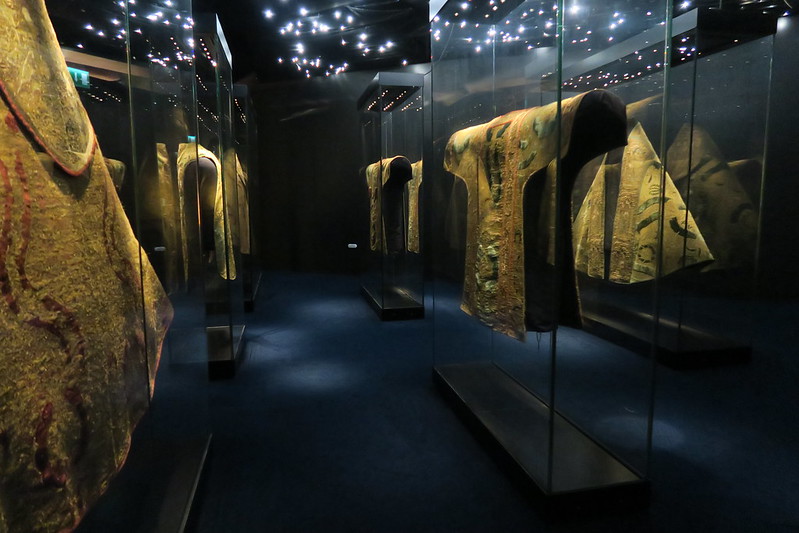
After a bit more exploring and watching the rowers on the river from our riverside hotel room and we enjoyed a relaxing evening.
Seaside Serenity: From Tramore’s Shores to Lafcadio Hearn’s Garden
It feels like I’ve finally settled back into a good routine with my morning yoga before breakfast, then heading off to catch the bus to picturesque seaside town of Tramore.
Arriving before the gardens we wanted to visit opened, we took a walk along the strand, thoroughly enjoying the tranquility before the crowds emerged.
Then onto Lafcadio Hearn Japanese Gardens; discovering the story of Lafcadio Hearn through 11 unique garden areas. These authentic Japanese Gardens reflect the life and extensive wanderings of Patrick Lafcadio Hearn (Koizumi Yakumo), who grew up in Ireland and whose life journey embraced several parts of the world. The gardens honour the fame he attained in Japan through his unparalleled literary descriptions of the people, customs, and culture of that country. Visitors can follow Lafcadio Hearn’s life journey from the Victorian Garden to the American and Greek gardens, culminating in the Japanese gardens, which feature an array of Japanese plants and architectural features. The Lafcadio Hearn Japanese Gardens are a sanctuary of beauty and tranquility for all who visit.
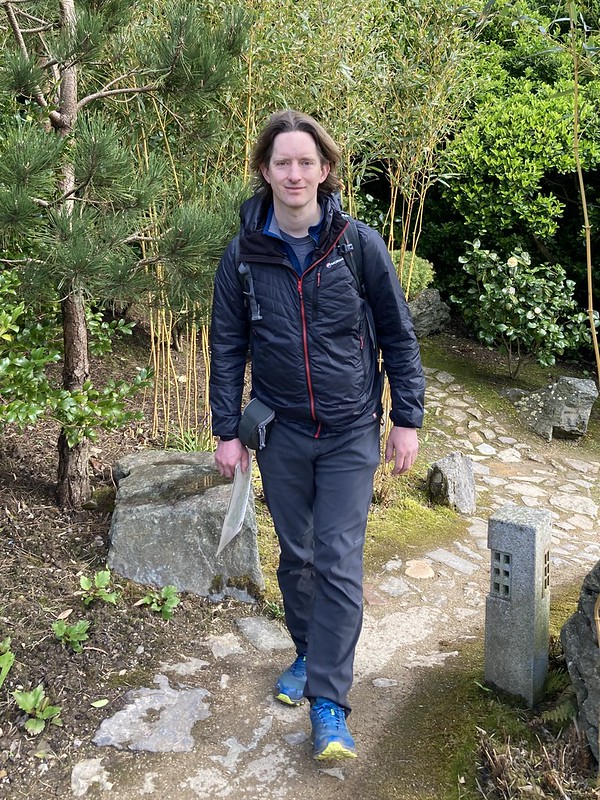
What an incredibly relaxing morning we had! Being early risers often makes us the first visitors, so we had the place to ourselves, aside from the half-dozen gardeners. The staff were wonderful, and we enjoyed a pause at the café overlooking the gardens to savour a drink before continuing along the coast to visit the Metal Man (perched atop one of three pillars serving as a navigation aid) and the swimming cove. Although we spotted someone braving a swim, we decided discretion was the better part of valour and stayed clear of the Atlantic swell. And what day by the sea would be complete without enjoying chips on the beach? Before we rounded off our visit with a bus ride back.
Greenway and Gardens: Discovering Waterford’s Natural and Cultivated Beauty
Another early start to catch the not overly frequent bus number 40 to Kilmacthomas for a section of the Waterford Greenway, a cycling and walking trail along a disused railway line. Also known locally as the Déise Greenway, traces its route on the former Mallow/Waterford railway track in County Waterford. At 46 km, it stands as Ireland’s longest greenway. So with only one day we opted to commenced our journey at the Kilmacthomas Viaduct, opting for a length more manageable on foot and conserving some energy for detours for sightseeing.
Starting at a walking pace allowed us to gradually settle into the experience, absorbing the atmosphere of the viaduct, the village, and the surrounding areas. The route offered a unique journey through the country’s scenic landscapes and historical sites. Our plan was to run about 8km of the section we anticipated would be most likely to be a little monotonous. Leading us quickly to the narrow-gauge tourist train line at Kilmeaden. What surprised us was our proximity of the walking and cycling trail to the Waterford and Suir Valley Railway, which shares the picturesque route along the banks of the River Suir.
Next we went on to the gates of Mount Congreve Gardens. Despite a slight hiccup getting the gate opened, a couple of phone calls later saw us wandering through the breathtaking gardens, adding more miles and memories to our legs.
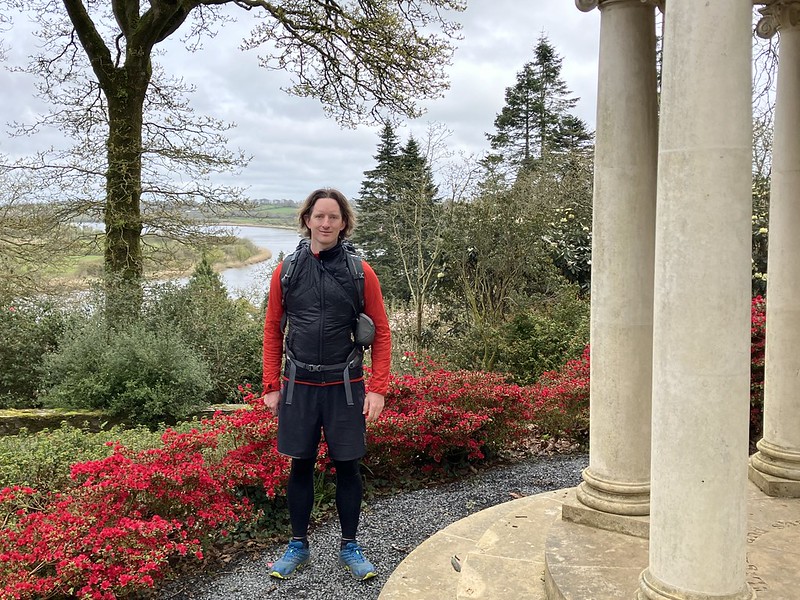
After our delightful visit to the gardens, we completed our journey back to Waterford. The route, enriched with lime kilns, a new toll bridge, an old railway bridge, a castle, a Viking settlement, passing trains, and fellow travellers, kept us engaged and slightly distracted. This less remote but historically rich final section offered plenty to explore.
Our adventure concluded with an evening of refuelling and preparing to start our journey back home the next day.
Ahead of the Storm: A Swift Farewell to Ireland’s Ancient South East
With another named storm expected, in a last-minute decision, we opted for the earliest ferry possible to try and stay ahead of the storm.
After a quick lap around the old walls of Waterford, mopping up the one remaining tower we had not visited ‘Beach Tower’, we returned to the hotel to collect our bags. Before a brisk walk to get our train. Thanks to our flexible tickets, we were able to rearrange our departure, a flexibility we appreciated with both the train and the ferry. Having flexible tickets truly paid off.
Our next challenge was deciphering the train carriage numbering. We had seats D 20 and D 24, but there were no visible numbers on the carriages.
We had a relaxed afternoon spent eating and relaxing in the departure lounge. However, the slightly earlier return had us arriving into Holyhead at 1am and a somewhat less comfortable night spent attempting to sleep at the ferry terminal, followed by the 4:25 train to begin the last leg of our journey home.
And now, it’s almost time to start planning our next adventure!